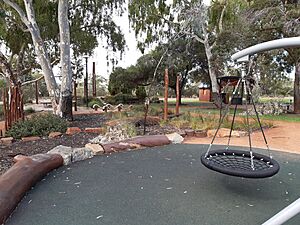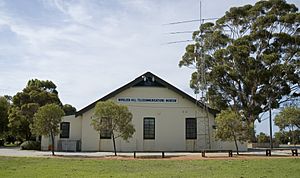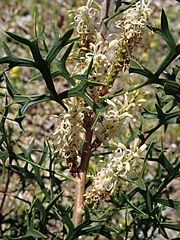Wireless Hill Park facts for kids
Quick facts for kids Wireless Hill Park |
|
|---|---|

Playground at Wireless Hill Park
|
|
| Location | Ardross, Western Australia |
| Open | |
| Designated | 2 September 1997 |
| Reference no. | 3518 |
Wireless Hill Park is a large park in Ardross, Western Australia. It covers about 40 hectares (that's like 100 football fields!). This park is special because it used to be home to the Applecross Wireless Station. This was one of the first radio stations in Western Australia.
The old station buildings are still there. They now house the Wireless Hill Museum. The whole area is important for its history and nature. It is listed on the State Register of Heritage Places. The park also has a lot of natural bushland.
Contents
History of Wireless Hill
Wireless Hill is on the traditional land of the Beeliar group. They are part of the Whadjuk Noongar people. They have lived in this area for thousands of years. They call this place Yagan Mia.
Building the Wireless Station
In 1909, the Australian government decided to build wireless telegraphy stations. These stations would be placed along the coast. The next year, a company called Australasian Wireless Limited was hired. Their job was to build the Perth station. This station was built at the spot we now call Wireless Hill.
Work on the site began in 1911. The Applecross Wireless Station was finished and officially opened on September 30, 1912.
Who Owned and Ran the Station?
At first, Australasian Wireless owned and ran the station. They did this for the Postmaster-General's Department (PMG). It was a service for ships. Ships could send and receive messages.
During World War I (1916-1920), the Royal Australian Navy took over the station. They also took control again during World War II (1939-1945). The Navy kept the same staff. In 1947, a new group called the Overseas Telecommunications Commission (OTC) took control. They managed all wireless stations.
The Station Closes and Becomes a Park
Between 1967 and 1968, OTC moved its operations. They moved to a new station in Gnangara. So, in 1968, the Wireless Hill station closed down.
The land was given to the City of Melville in 1969. In 1971, it was officially named Wireless Hill Park. People in the area already called it Wireless Hill.
The Wireless Hill Museum
In 1970, a group of amateur radio fans had an idea. They wanted to create a museum about telecommunications. Work started in 1974 to turn the old station into a museum.
In 1979, the Wireless Hill Telecommunications Museum opened. This was part of Western Australia's 150th birthday celebrations. The museum was updated in 2015. It then reopened as the Wireless Hill Museum.
Wireless Hill Park was recognized as important in 1992. It was listed on the Western Australian Register of Heritage Places in 1997.
Wireless Hill Museum and Technology

Wireless Hill Museum, 2006
|
|
| Established | 1974 |
|---|---|
| Location | Ardross, Western Australia |
|
Building details
|
|
| Former names | Engine House |
| Alternative names | Engine Room |
| General information | |
| Groundbreaking | 1911 |
| Opened | 30 September 1912 |
| Official name | Engine House (fmr) |
| Designated | 3 Aug 1992 |
| Reference no. | 3825 |
Buildings and Structures at the Station
At the top of Wireless Hill, there are three main buildings. They were built in 1912.
- Engine House (or Engine Room): This building originally held the generator. The generator made power for the radio transmitter. In 1942, the radio equipment moved into this building. It was then called the Transmitter Hall.
- Operator's House (or Operator's Room): This is where the radio equipment was kept until 1942.
- Stores building: This building was added around 1915.
When the station first opened, it had a very tall antenna mast. It was 120 meters high (that's taller than a 30-story building!). It was held up by strong wires called guy-wires. Each wire was attached to a huge concrete block. In 1930, a light was put on top of the mast. This was to warn aircraft at night.
In 1962, the original tall mast was replaced. A shorter, 46-meter mast was put up. Newer technology meant they didn't need such a tall mast anymore. The mast was removed completely in 1967. Today, one of the old concrete anchor blocks is used as a viewing platform.
In 1947, three wooden towers were built. They helped send signals to special antennas called rhombic antennae. These towers were removed around 1970.
At the bottom of the hill, near Hickey Street, there were four cottages. These were built for the staff to live in. The road between the cottages and the main station was called Radio Drive. It might have been the first macadam road in Perth.
Cool Radio Equipment and How it Worked
When the station opened in 1912, it used a special transmitter. It was a 25 kW (kilowatt) quenched-spark transmitter. It also had a receiver with a crystal detector. This detector used a mineral called galena.
In 1916, the Navy upgraded the transmitter. They installed a more powerful 60 kW Poulsen arc transmitter. They also added a new receiver that used vacuum tubes.
At first, all radio messages used Morse code. This is a system of dots and dashes. The technology to send voices over radio came later, in the 1920s. But Morse code was still the main way to send messages over long distances until the station closed in 1968.
In 1927, a "beam system" was installed. This used shortwave radio. It made the transmission range much longer. It allowed direct communication between Australia and England!
The original transmitter was powered by a diesel engine. By 1934, the equipment used electricity from outside the station. The diesel generator was kept for emergencies.
Over the years, many antennas were added. Each one had a specific job. In 1960, two rhombic antennas were installed. These were used for NASA space missions! This brought the total number of antennas to 22.
Radio Services Provided
The Wireless Hill station offered many different radio services.
- Ship Communications: At first, it was mainly used to talk to ships. This included sending weather forecasts, news, and time signals. They also sent medical advice to ships that didn't have doctors. And they listened for distress calls from ships in trouble. In 1921, the station talked to a ship called the SS Aeneas. They communicated over 9,000 kilometers! This was the longest distance for any Australian station at that time.
- Long-Distance Communication: Wireless Hill was the first station to provide direct radio communication across Australia. It also communicated with bases in the Antarctic. This included Mawson Station in the 1950s and 1960s.
- Call Signs: The station's first call sign was POP. By the 1920s, it was known as VIP.
- World War I Monitoring: During World War I, the station listened to German radio messages.
- Police Radio: Police radio (VK-1) was sent from Wireless Hill. It was controlled from the police headquarters in Perth. In the late 1920s, only two police cars in Perth had radios.
- Commercial Radio and TV: Western Australia's first commercial radio station, 6PR, broadcast from Wireless Hill. This was from 1931 to 1950. Western Australia's first television service (TVW7) also broadcast from here in 1959.
- NASA Support: In the 1960s, the station helped with Project Mercury space missions. It provided communication for US rescue aircraft. These planes flew over the Indian Ocean during NASA missions.
- Amateur Radio Today: A shortwave antenna was installed in the 1970s. It is still used today by the WA VHF Group, an amateur radio club.
- Emergency Communications: After Cyclone Tracy hit Darwin in 1975, communications were badly damaged. The WA VHF Group helped provide communication between Darwin and Perth. In the 1980s, an antenna was added to the Stores building. This building became the control center for the State Emergency Service.
- Community Radio: Since 2002, Wireless Hill has been home to Capital Community Radio's studios. It also has one of their transmitters.
Bushland and Nature
Wireless Hill Park has about 38 hectares of bushland. It also has 2 hectares of grass parkland. The bushland is home to many wildflowers, native plants, birds, and reptiles. It is listed as "Bush Forever" site 336. This is a state government plan to protect important bushland areas.
Much of the area was cleared when the Applecross Wireless Station was built. This was also done for security during World War I. A type of grass called perennial veldtgrass was planted to stop soil from washing away. But the bush has grown back naturally from seeds.
The park has several walking paths for visitors to enjoy.
Aboriginal Heritage
Wireless Hill is on the land of the Beeliar group of the Whadjuk Noongar people. They call this place Yagan Mia.
Some people used to think Yagan Mia meant Yagan's Lookout. They thought it was named after the Whadjuk leader Yagan. He used the area as a home base and a lookout spot.
However, more recent information tells us that Yaagan means 'turtle'. It specifically refers to the (western) long-necked turtle. So, Yagan Mia means 'home of the long-necked turtle'. These turtles were an important food source for the Noongar people.
The park also has a scarred tree on its southern side. This is a tree where Aboriginal people removed bark for tools or canoes.
See also
- Timeline of Australian radio




